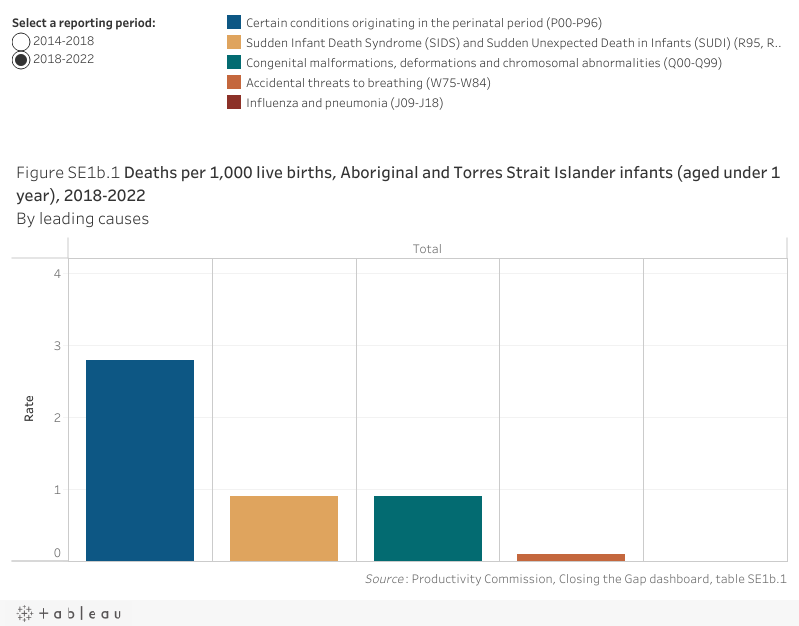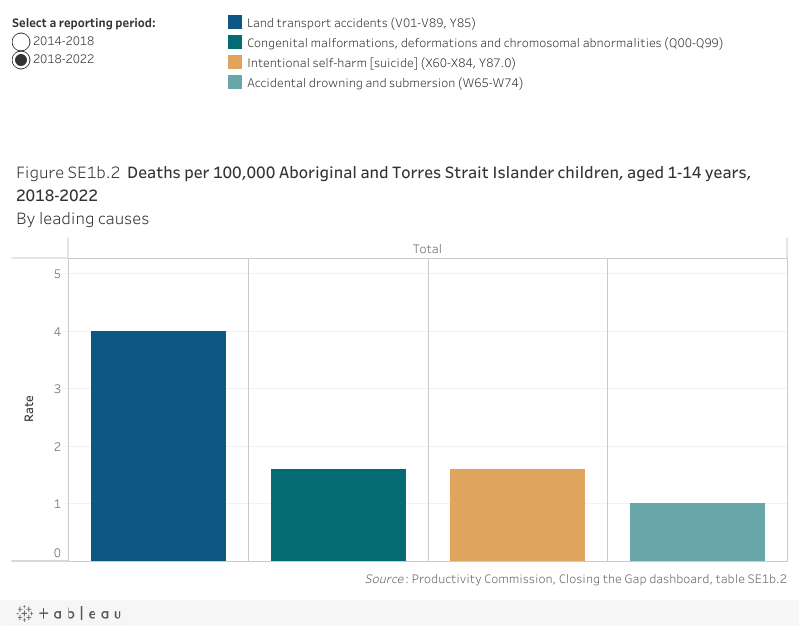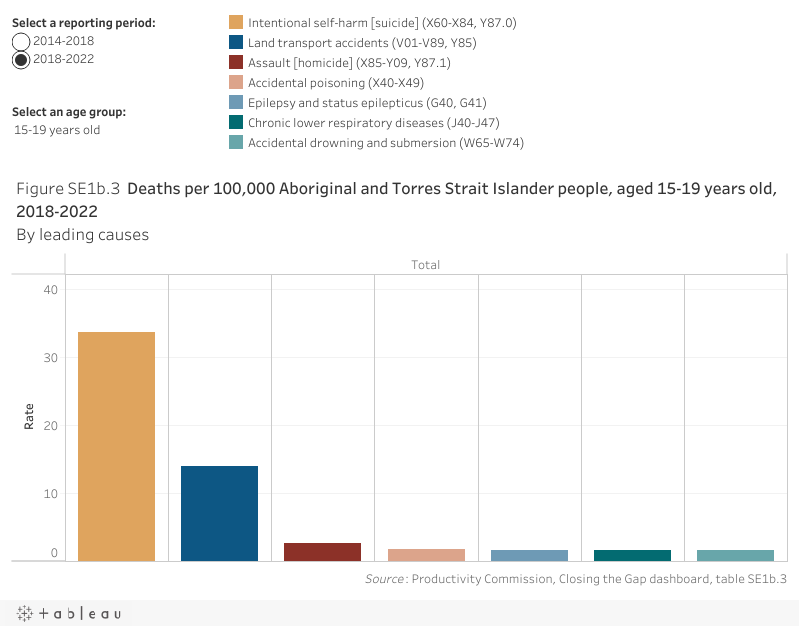Driver
Leading causes of death
Infant mortality, child mortality, and five-yearly age groups
Data tables appear under figures
Measure 1
Infant mortality rate, by the leading causes of death
Nationally in 2018–2022, the leading cause of death for Aboriginal and Torres Strait Islander infants (aged under one year) was certain conditions originating in the perinatal period (2.8 per 1,000 live births). These include, for example, conditions related to short gestation and low birthweight, birth trauma and viral diseases acquired in utero (figure SE1b.1).
Between 2014–2018 and 2018–2022, this rate decreased (from 3.4 per 1,000 live births). The rates for all other leading causes remain under 1.0 per 1,000 live births.

Measure 2
Child mortality rate, by the leading causes of death
Nationally in 2018–2022, the leading cause of death for Aboriginal and Torres Strait Islander children (aged one to 14 years) was land transport accidents (4.0 per 100,000 children) (figure SE1b.2).
This is higher than the rate in 2014–2018 (3.6 per 100,000 children). The rates for all other leading causes remain 2.0 or less per 100,000 children.

Measure 3
Mortality rate, by the leading causes of death
For Aboriginal and Torres Strait Islander people in younger age groups (five-year age groups from 15 to 39 years) the leading cause of death is intentional self-harm. From 2014–2018 to 2018–2022, the rate of deaths due to intentional self‑harm increased for Aboriginal and Torres Strait Islander people in the age groups: people aged 15 to 19 years, 25 to 29 years and 35 to 39 years. But rates decreased for the age groups: people aged 20 to 24 years and 30 to 34 years (figure SE1b.3).
From people aged 40 to 74 years of age (five-year age groups) the leading cause of death for Aboriginal and Torres Strait Islander people is ischemic heart disease. From 2014–2018 to 2018–2022, these rates have decreased in most age groups, with the exception of those aged 40 to 44 years, 50 to 54 years and 70 to 74 years.
For Aboriginal and Torres Strait Islander people aged 75 years or over, dementia has overtaken ischemic heart disease as the leading cause of death (in 2014–2018 compared to 2018–2022).

Indicator data specifications
Related Outcome: | Aboriginal and Torres Strait Islander people enjoy long and healthy lives. |
|---|---|
Related target: | Close the Gap in life expectancy within a generation, by 2031. |
Indicator: | Leading causes of death (infant mortality, child mortality, and five‑yearly age groups) |
Measures: | There are three measures for this indicator. Measure 1 is the infant mortality rate (for persons aged less than one year), by the leading causes of death and total, defined as: Numerator – number of deaths for Aboriginal and Torres Strait Islander children aged less than one year, by ICD-10 cause groups Denominator – number of Aboriginal and Torres Strait Islander live births and is presented as a rate per 1,000 live births. Measure 2 is the child mortality rate (for persons aged one to 14 years), by the leading causes of death and total, defined as: Numerator – number of deaths for Aboriginal and Torres Strait Islander children aged 1–14 years, by ICD‑10 cause groups Denominator – number of Aboriginal and Torres Strait Islander children aged 1–14 years and is presented as a rate per 100,000 population. Measure 3 is the mortality rate, for persons aged 15 years or over, by the leading causes of death and total, by age group (five‑year age groups for ages 15–74 years, and 75 years or over), defined as: Numerator – number of deaths for Aboriginal and Torres Strait Islander people, by age group, by ICD‑10 cause groups Denominator – number of Aboriginal and Torres Strait Islander people, by age group and is presented as a rate per 100,000 population. |
Indicator established: | National Agreement on Closing the Gap July 2020 |
Latest dashboard update for the indicator: | 6 March 2024 |
Indicator type: | Driver |
Interpretation of change: | For all measures, a decreasing rate is desirable. |
Data source(s): | Numerator (all measures) Name: Australian Bureau of Statistics (ABS) Causes of Death Collection Frequency: Annual Documentation (links): https://www.abs.gov.au/statistics/health/causes-death/causes-death-australia/ Denominator (measure 1) Name: Births Australia Frequency: Annual Documentation: https://www.abs.gov.au/statistics/people/population/births-australia Denominator (measures 2 and 3) Name: Estimates and projections for Aboriginal and Torres Strait Islander Australians Frequency: Annual (data revised on a five‑yearly basis) |
Data provider: | Provider name: ABS Provider area: Health and Vitals (numerator); Demography (denominators) |
Baseline year: | 2014–2018 (five-year aggregate) |
Latest reporting period | 2018–2022 (five-year aggregate) |
Disaggregations: | Infants (Children under one year) by the leading causes of death (and total) and all cause total, by years (five years combined) by selected states and territories (and total), by Indigenous status. Children 1–14 years by the leading causes of death (and total) and all cause total, by years (five years combined), by selected states and territories (and total), by Indigenous status. People aged 15 years or over by age group (5‑year age groups and 75 years or over), by the leading causes of death (and total) and all cause total, by years (five years combined), by selected states and territories (and total), by Indigenous status. |
Computation: | Measure 1: Numerator divided by Denominator multiplied by 1,000. Rates use the total of the five years for numerator and total of five years for denominator. Measures 2 and 3: Numerator divided by Denominator multiplied by 100,000. Rates use the total of the five years for numerator and total of five years for denominator. Data are provided for non‑overlapping time periods, other than for the latest reporting period. Counting rules Numerator (all measures) Aggregate number of deaths, over the five‑year time period. Reporting is only for those jurisdictions which have adequate levels of Indigenous identification (New South Wales, Queensland, Western Australia, South Australia and the Northern Territory from 1998). Excludes deaths where Indigenous status was not stated. From 2016, deaths with not stated age have not been prorated and are excluded from analysis. Data are presented for the underlying cause of death according to the International Statistical Classification of Diseases and Related Health Problems, Tenth Revision (ICD-10). The World Health Organisation (WHO) defines the underlying cause of death as the disease or injury that initiated the train of morbid events leading directly to death. Data are provided for the ‘leading causes of death’ based on the WHO recommended tabulation of leading causes, For further information see: https://www.abs.gov.au/methodologies/causes-death-australia-methodology/2021#mortality-tabulations-and-methodologies Where possible, the leading causes of death are presented as the top five cause groups listed from highest to lowest Indigenous rate, for each age group, for the most recent period (five years combined). A top six is presented if there are equal number of deaths for the causes listed as the fifth leading cause of death. Less than top five causes may be listed if there are only a small number of deaths against some of the causes. The leading causes of death need to be re‑assessed each reporting period. If a change is identified, data may need to be backcast to the baseline year for the most recent set of leading causes to ensure a consistent time series. Denominator (measure 1)
Denominator (measures 2 and 3)
|
Data quality considerations: | Data are presented in five‑year groupings due to volatility of the small numbers involved. From 2014, cells with small values have been randomly adjusted to protect confidentiality. Some totals will not equal the sum of their components. Cells with a zero value have not been adjusted. Mortality rates based on a small numbers of deaths may volatile between reference periods. Age‑specific death rates based on a very low death count have not been published, and appear as 'np'. Age‑specific death rates based on a number of deaths below 10 should be treated with caution. Mortality rates by Indigenous status are produced for New South Wales, Queensland, Western Australia, South Australia and the Northern Territory only. Aboriginal and Torres Strait Islander mortality rates are not produced for Victoria, Tasmania and the Australian Capital Territory due to the small number of Aboriginal and Torres Strait Islander deaths reported in these jurisdictions. The ABS Deaths and Causes of Death reports identify a death as being of an Aboriginal and Torres Strait Islander person where the deceased is recorded as Aboriginal, Torres Strait Islander, or both on the Death Registration Form (DRF). For 2022 for New South Wales, information from the Medical Certificate of Cause (MCCD) of Death has been used for the first time. For more information on this change and the impacts refer to Technical Note: The impact of using two sources for deriving the Indigenous status of deaths in NSW in 2022. The use of this information from the MCCD has been introduced at different times across jurisdictions depending on when systems and processes have allowed for the ABS to use as follows:
Caution is required when interpreting trends in mortality rates, because of changes in Indigenous identification across data collection and over time, and variation across geographies and socio‑economic groups. Although most deaths of Aboriginal and Torres Strait Islander people are registered, it is likely that some are not accurately identified as Aboriginal and Torres Strait Islander people. Therefore, these data are likely to underestimate the Aboriginal and Torres Strait Islander mortality rates. |
Future reporting: | Additional disaggregations required for future reporting:
|
